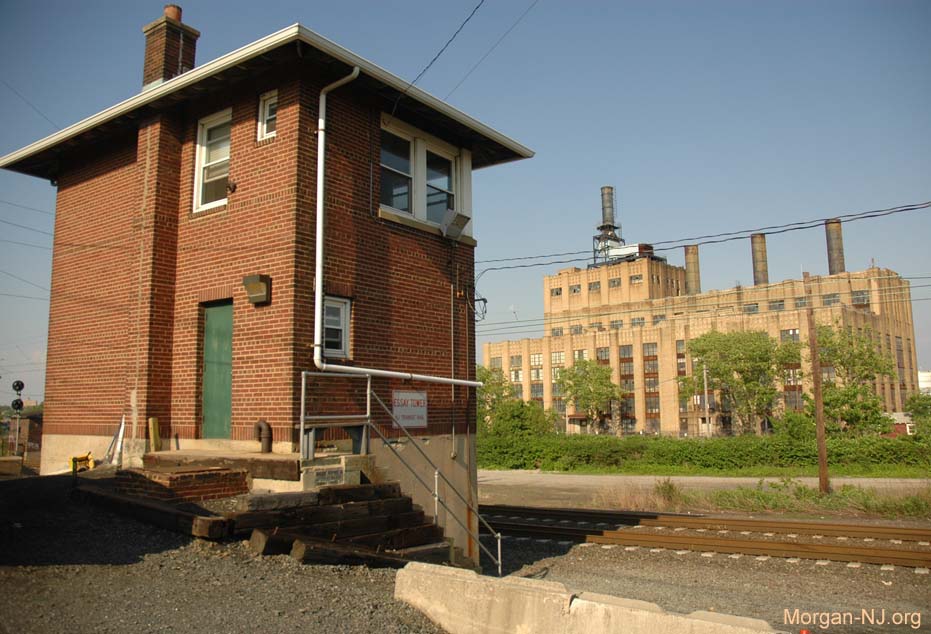
Morgan Monuments – South Amboy Tower
Stationed as a silent sentinel located just before the bridge over the river Raritan and on the other side of the tracks from the long-time site of the E. H. Warner Power Station is South Amboy Tower. Made of brick and better known as “Essay Tower,” due to the abbreviation of South Amboy – “SA” – “Essay”, at one time the tower was critical to the daily operations of the railroads right around it that it served. Now it has no real practical purpose and, even worse, shortly it will be totally gone.
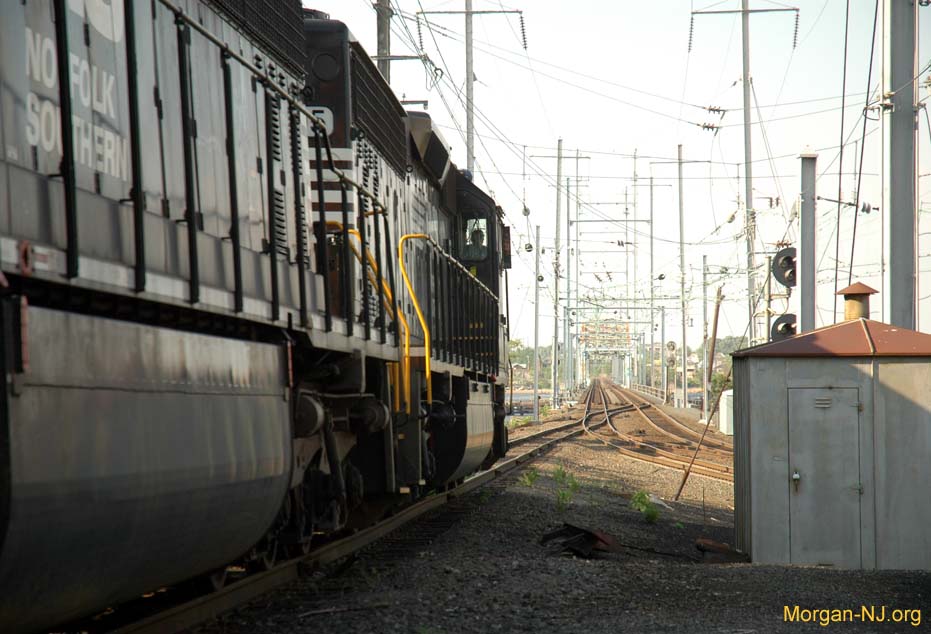
The corridor where the original Camden and Amboy Railroad (C&A), New York and Long Branch Railroad NY & LB) / Central Railroad of New Jersey (CNJ) / Pennsylvania Railroad (PRR) and Raritan River Railroad tracks met abutted the bridge over the Raritan River. Coordinating all the railroad traffic through this short corridor was very involved and required careful efforts.
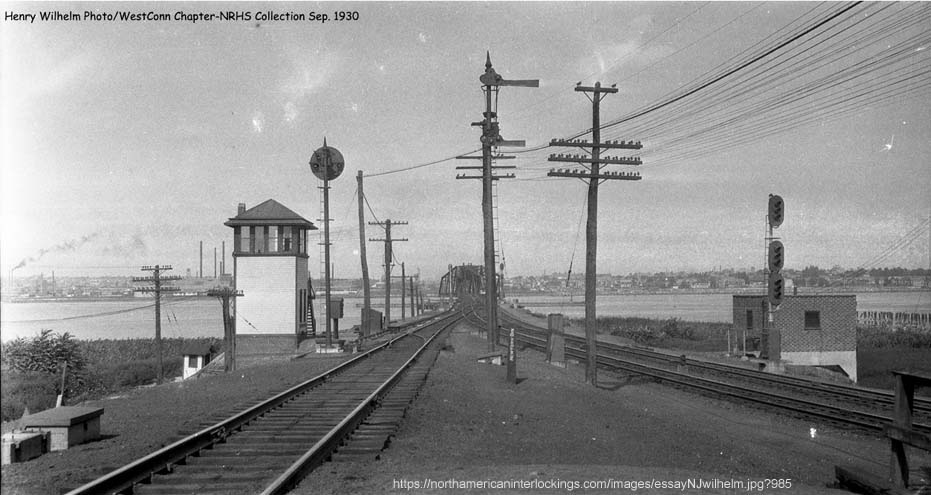
Old photographs from a simpler time, i.e., before the railroad was electrified between South Amboy and Pennsylvania Station in Manhattan, show an earlier wooden “SA” Tower located northeast of the current Essay Tower between the intersection of the C&A with the NY&LB track lines and the bridge.
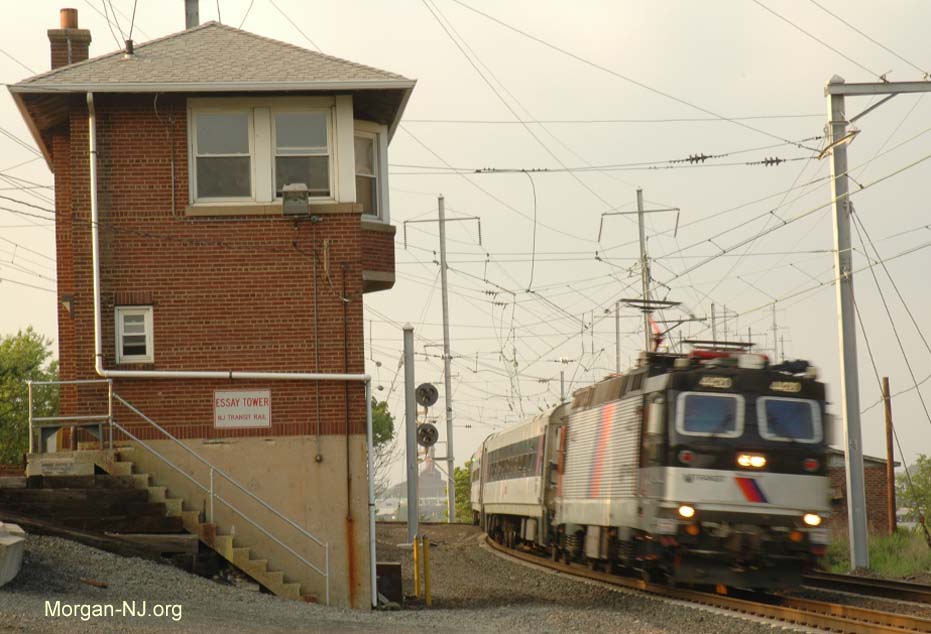
What the…?
The obvious questions are what were the Essay Towers used for and when was the current one built?
In its heyday, Essay Tower was what is known as an Interlocking Tower. Trying to get a clear understanding of what an Interlocking Tower does (or did) is very difficult if one asks an old-time train guy. Much like when trying to ask a similar type of question to a present-day software engineer, you end up hearing endless unintelligible terms and acronyms. In short, the purpose of an Interlocking Tower was to make sure trains didn’t crash into each other.

They did this – “did” because nearly all Interlocking towers have been replaced by newer technologies – by being the entity that changes the position of the railroad track switches and any specific traffic signals which correspond to those switches. The controls which do the coordination between the switches and the tracks are “interlocked” with each other, meaning until the switches are in the right combination, the signals are “locked” in the position to not allow trains to move into the segment of railroad track called a “block.” A block is a segment of track for which only one train at a time is allowed. The length of a block varies but as a minimum, it has to be long enough to fit the longest train which would travel on that railroad line and have sufficient distance to allow for that fully loaded train to stop when that train was traveling the highest allowed speed.
Automobile drivers have a somewhat similar setup regarding signals and whether or not a car should proceed.
Records from the National Railroad Adjustment Board from November 1966 give some insight into the duties of the people who worked inside the Essay Interlocking Tower:
… The duties of the Block Operator at South Amboy include the handling of switches and signals necessary to the movement of Pennsylvania, Central Railroad of New Jersey and Raritan River Railroad trains through the interlocking tower, and to perform the related communications work…
… South Amboy Tower is located on what is known as the New York and Long Branch Railroad, jointly owned and operated by the Pennsylvania Railroad and the Central Railroad of New Jersey. The Raritan is jointly owned and operated by the Pennsylvania and New York Central. There are numerous train operations through “SA” Tower on behalf of the Pennsylvania, the Central Railroad of New Jersey, and the Raritan River Railroad.
“SA” Tower is manned by employees of the Pennsylvania Railroad. “WC” Tower (Woodbridge Junction), 2.3 miles east of “SA” Tower, is staffed with employees of the New York and Long Branch Railroad…
… During normal operations of a train moving from the Raritan River Railroad to the New York and Long Branch Railroad, the Pennsylvania Railroad Operator at “SA” operates from the tower the electric lock switches located at the Raritan River interchange point and displays necessary signals under which other trains are prohibited from entering the block…
So, it seems that there have been at least two different Interlocking Towers dubbed “Essay Tower” though it isn’t clear yet when the first one was built. Most likely it was built either in conjunction with the building of the 1908 Raritan River railroad bridge or subsequently. The above image was taken sometime prior to the 1930s electrification of the railroad between the entrance to the Hudson River tunnels near Jersey City and South Amboy.
Thanks to reader William Strassner, who worked at WC Tower starting in 1968 and is ex-president of the CNJ Veteran Employees Association, for clarifying that the employees of WC Tower actually worked for the Central New Jersey Railroad.

Through the miracle of the internet, everyone has access to this September 1942 “Railway Signaling” article which provides further details about the setup and workings of a “New Electro-Pneumatic Plant Installed on the N.Y. & L.B.” Remarkably, this article focuses exclusively on the current Essay Tower!
While this September 1942 article doesn’t explicitly indicate when the tower was built, it does indicate new equipment was “recently placed in service… to replace a plant previously destroyed by fire…”
Fortunately, the December 2, 1938 issue of the South Amboy Citizen does answers why the newer/current Essay Tower was built – though it doesn’t – and couldn’t – indicate when the current one was built and became operational:
TRAIN SERVICE DELAYED WHEN FIRE DESTROYS “S. A.” R’WAY TOWER
Shortly after four o’clock Saturday morning [November 24, 1938], a fire broke out in “SA” tower of the Pennsylvania Railroad, located close to the track junction near the bridge over the Raritan River. The fire had gained such headway, that firemen were unable to prevent the complete destruction of the building. It is believed the fire started from an overheated stove.
The fire put the signal systems out of commission and electric power was temporarily shut off and this was said to have caused the cancellation of three electric trains. Many commuter trains were late as the result of the fire and it was necessary for a few days to make all the train movements through the local area on hand signals.
If any reader knows the actual dates either or both Essay Towers were opened, please leave a note in the comments section, below.
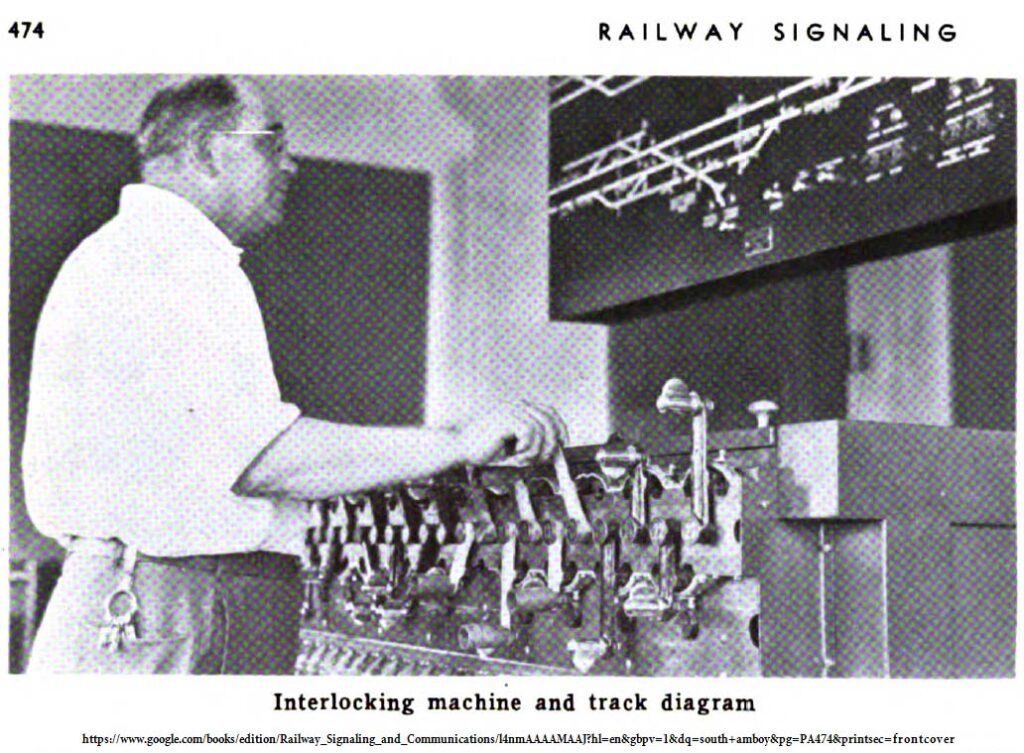
What was on the Inside?
The September 1942 Railway Signaling and Communications issue shows numerous images of the various components inside and outside of Essay Tower. The above image shows an operator with his hands on a lever of the Union Switch & Signal (US&S) Company Model 14 Type “F” Electro-Pneumatic Interlocking Machine while viewing the status of the switches and signals on the overhead model board.
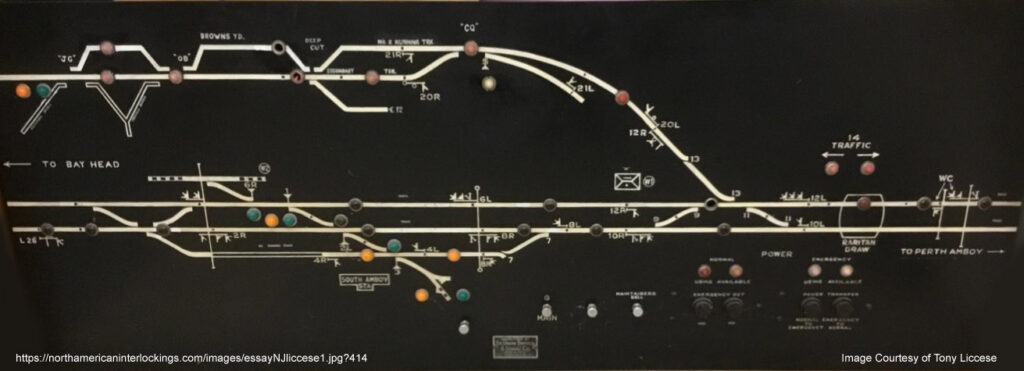
This web link referenced in the above image appears to show the actual model board which was removed from Essay Tower sometime after the tower’s usefulness was over. Note that it differs slightly from the model board shown in the 1952 image in Railway Signaling Magazine. The model board, originally in a case 4 ft. 11 in. long, 22 ½ in. high and 5 ½ in. deep, has two horizontal lines representing the mainline tracks with the Morgan side on the left and the bridge side on the right.
The line located a third of the way in from the right which goes up and to the left is what was the Camden and Amboy line and includes Browns Yard in nearby Sayreville (shown on the model board as “Browns”) and is still in use. Recall that the Camden and Amboy Railroad was the first commercial railroad in New Jersey. The spur marked “21L” connected the C&A to the pier area.
The South Amboy Train Station is the box on the bottom just left of center marked “SOUTH AMBOY STA”. The line just above it and the short line to its right going toward the bottom were used in the days when engines were switched (more on that topic in a future article).
The Raritan River Railroad is the short horizontal line just to the right of the text which says “TO BAY HEAD” and above the switch marked “6R”.
Using the levers of the US&S Interlocking Machine, the operator inside Essay Tower would change the settings of the track switches and their corresponding signals. Lights on the model board would change correspondingly. In the days before computers when freight was mostly moved by train, operators in Essay Tower would be very busy. According to the 1942 Railway Signaling article:
The traffic handled by this interlocking consists of approximately six freight trains daily and 140 passenger trains. Many of these passenger trains operate on close headway. On the [Camden and] Amboy branch of the Pennsylvania, which handles mostly coal, there is an average of 12 freight and 2 passenger trains a day. In addition, about 50 switching moves a day are made between “SA” and Brown’s, 6 or 7 miles away.
The 1942 article also includes a section that provides even more detail about the model board!
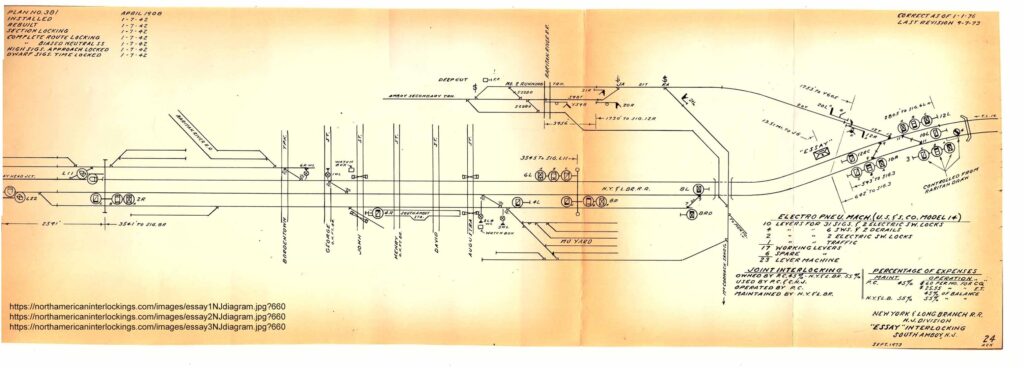
The above interlock diagram, found on the NorthAmericanInterlockings.com web site, provides additional information regarding just how complicated the railroad lines in South Amboy were. This was during the time before the current passenger station was built when the passenger station was located on the bay side of the tracks. While now John Street is the only street-level railroad crossing in the downtown area (John T O’Leary Blvd wasn’t a street yet), at that time there were multiple street-level railroad crossings which necessitated manual operators for the crossing gates. The model board inside of Essay Station provided a simplified representation of this complicated topography.
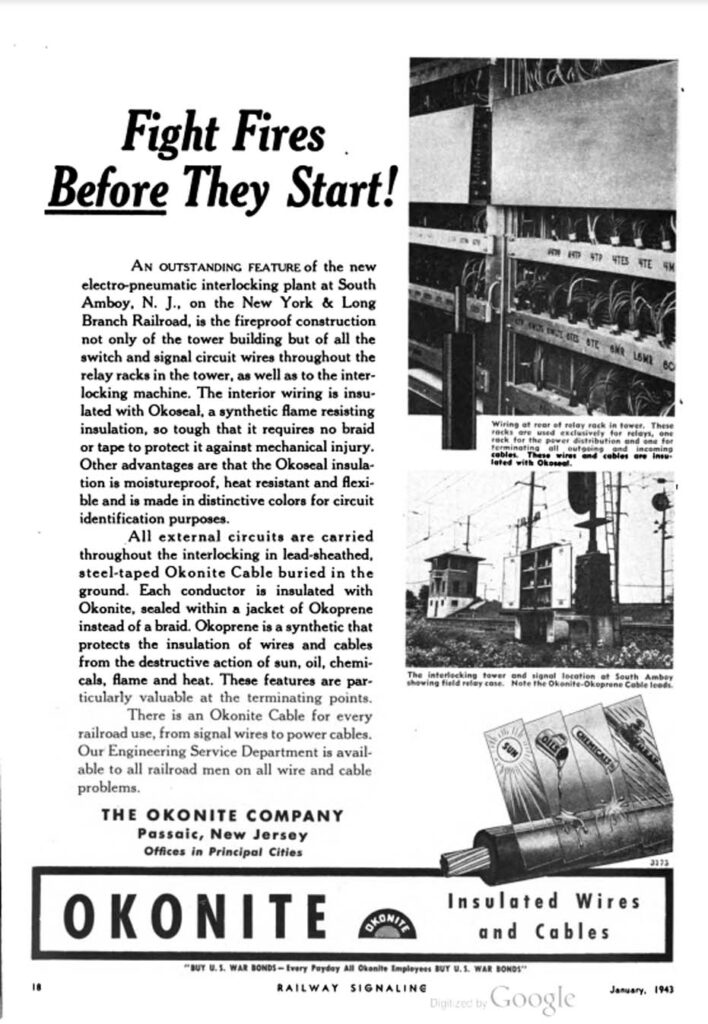
Essay Tower was important enough that the Okonite Company took out an advertisement for it!
It is remarkable that an image of the model board was able to be found. Wonder where this model board is physically located now? It would be lovely if it could be donated to the Historical Society of South Amboy so it can be displayed in their museum!
Recent Views Inside Essay Tower
In 2018, workers inside Essay Tower were kind enough to let a few of us associated with the Historical Society of South Amboy take a peek inside. While all the equipment which made the interlocking tower an interlocking tower was long gone – including the interlocking machine and model boards – we appreciated being able to peek inside and also see the view from some of the windows.
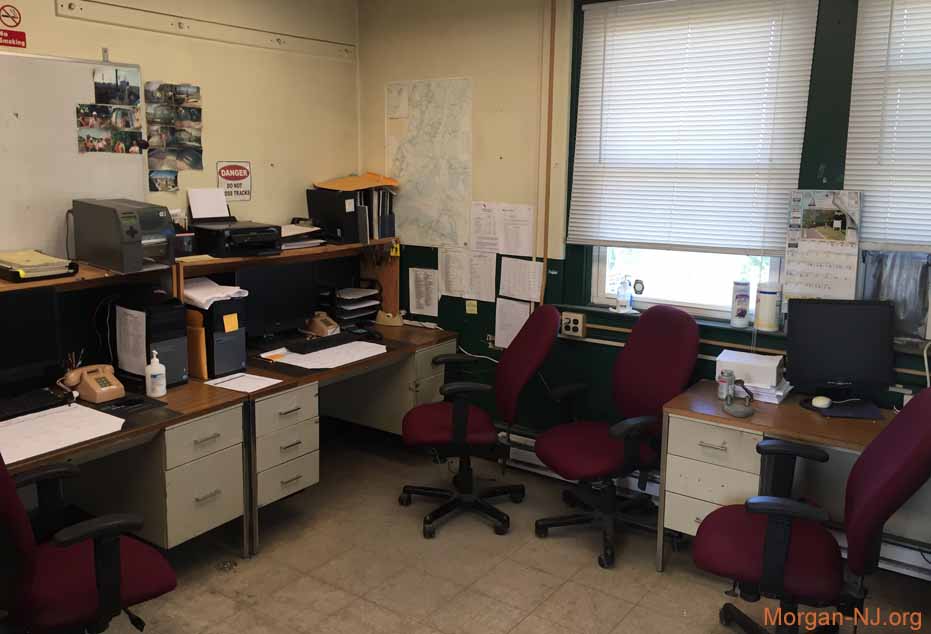
This is the room that used to contain the interlocking machine, model board, and all the communications devices. As of the time of this photo, it was an office.
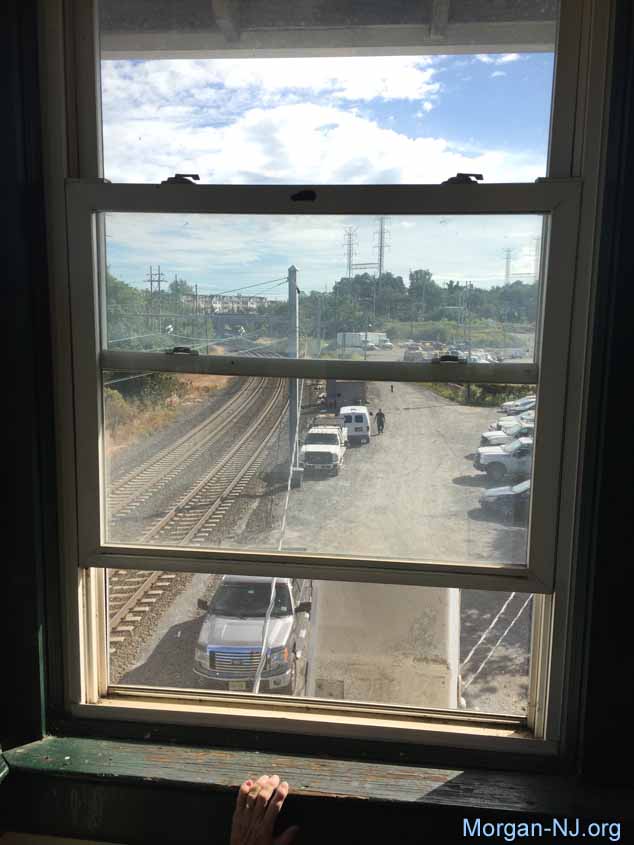
Looking through the south-facing window towards the condos on Main Street.

Looking through the East facing window toward the site previously occupied by the E. H. Warner Power Station and the mainline tracks.
Essay Tower Decommissioned
For 40+ years starting from some time in the 1930s, a unique thing would happen in South Amboy every day. Because the railroad tracks between New York City’s Penn Station and South Amboy were electrified but the tracks south of South Amboy through Matawan to Bay Head were not electrified, trains traveling south of South Amboy (through Morgan) had to change their engines in South Amboy. The crew in Essay Tower was instrumental in this locomotive switching dance.
From the 1930s until late in the 1950s, the South Amboy switch was between electric powered engines, such as the celebrated GG-1, and steam engines such as the K4. After the age of steam ended, the switch was between electric-powered engines and diesel-powered engines.
The necessity to swap engines in South Amboy ended completely sometime in the 1980s when electric trains could travel all the way to Matawan (later to Long Branch). This, combined with the lower needs of the other railroads and probably further improvements in railroad technology meant the complicated coordination through South Amboy between the various railroads was no longer needed. This meant ultimately that Essay Tower was therefore no longer needed and subsequently Essay Tower was “closed” as an Interlocking Tower on July 2, 1986.

The Future of Essay Tower’s Location
As of the time of this writing, an important part of the effort underway to replace the present 1908 railroad bridge across the Raritan River between South Amboy and Perth Amboy with a new bridge is the realignment of the two mainline railroad tracks located between the new bridge and the current South Amboy NJ Transit railroad station. The new tracks will be a little higher to accommodate the higher bridge but more importantly, the position of the new bridge in relation to the station will necessitate the path of the tracks to go right through the spot where Essay Tower stands.
The good news is that the new pathway of the railroad tracks will have a less sharp curve. This will allow for trains to travel faster between the station and over the bridge. Who knows, maybe someday in the future, really fast trains will travel on these tracks.
Of course, the bad news is that Essay Tower will need to be torn down to accommodate the new right of way.
More Recent Photos of Essay Tower
This site has a number of more recent Essay Tower photos, taken by William Billson, than the interior ones shown above. You can tell they are more recent because the office has been gutted and, in some of the photos, construction efforts for the new Raritan River bridge can be seen.
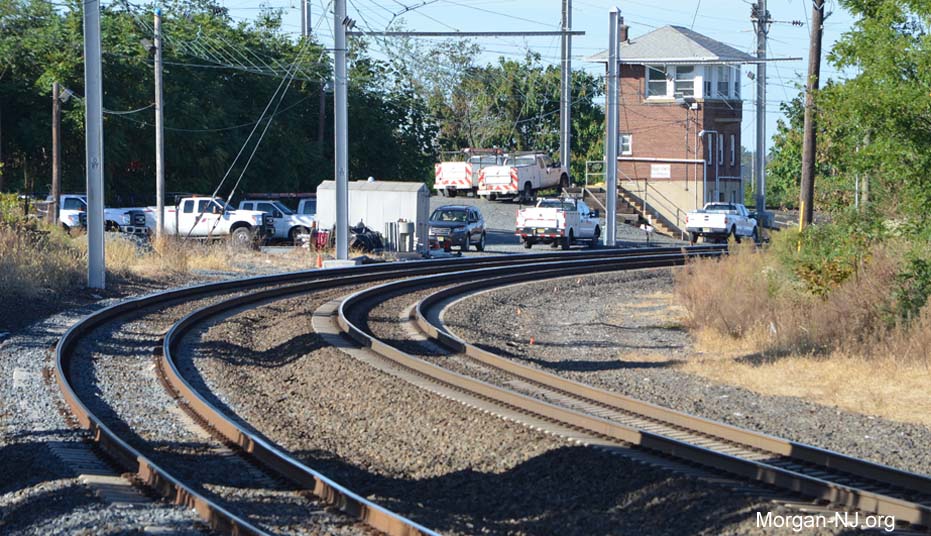
Final Thoughts
My school friend Ken tells the story of meeting up with some German tourists some years ago at Essay Tower. They were model railroad enthusiasts (HO gauge) and their main purpose in visiting the United States was to the Raritan River Railroad (or what’s left of it). At the end of their tour, they visited Essay Tower (“Ja! Ja! Inta-lokking tower! Ja!”) Apparently, it is a well-known landmark in some international railroad circles.
It would probably be fair to say that most people living near Essay Tower have no idea of its original purpose, its history, or its significance. I certainly used to be one of those people (but I no longer live near it).
Originally posted on July, 31, 2022.
